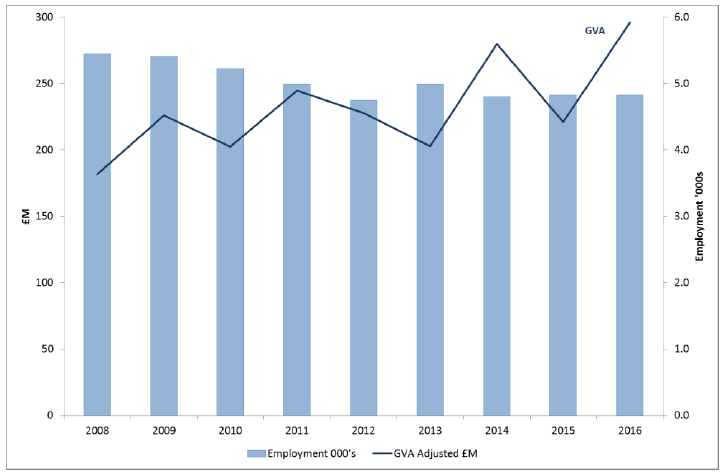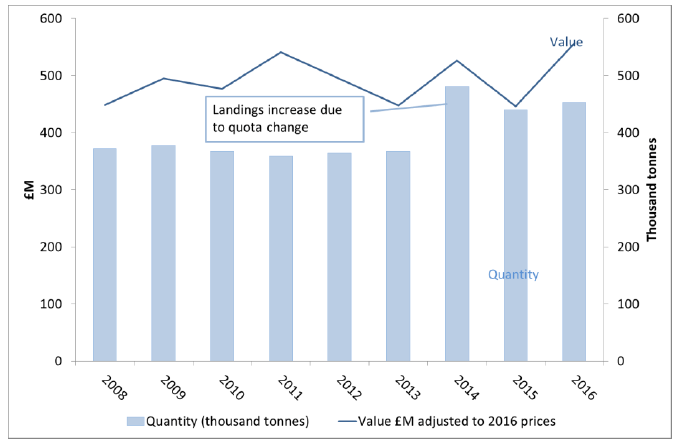Scotland's marine economic statistics 2016
The publication presents economic statistics for industrial categories defined as part of the marine sector.
This document is part of a collection
3. Fishing
3.1 Introduction
Scotland’s fishing fleet and sea fisheries are significant contributors to Scotland’s rural and coastal economies. The fishing industry contributes to Scotland’s food and drink economy, in particular playing an important part in many remote and potentially fragile communities.
In this section the economic contribution of the fishing sector has been estimated using Marine Scotland Sea Fisheries Statistics and Seafish Industry Authority Fleet Economic Survey published statistics. This approach provides a more reliable estimate of economic activity than the SABS figures, primarily because the turnover source data covers the entire population of fishing vessels. The Seafish survey provides financial data collected for the DCF, and this is used to estimate GVA for the Scottish fleet. Details of the methodology are provided in Annex B: Methodology and source data on page 67. Previous Marine Scotland topic sheets estimated GVA using Marine Scotland statistics, but using a different methodology as described in Annex B.
The latest sea fisheries statistics available at the time of writing are for 2017. However the GVA figures shown here depend on the latest fleet economic data which is for 2016 and which aligns with the latest available SABS data.
3.2 Key economic points
In 2016 fishing generated £296 million GVA: accounting for 0.2 % of the overall Scottish economy, and eight per cent of the marine economy.
In terms of employment, fishing provided employment for a headcount of 4,800 people, contributing 0.2 % to total Scottish employment, and 6 % of the marine economy employment.
From 2015 to 2016 the GVA from fishing (adjusted to 2016 prices) increased by 34%, while the longer term trend from 2008 to 2016 showed that fishing GVA increased by 63%
Over the same period, employment fell by 11%, though it has been stable in recent years.
The GVA per worker (adjusted to 2016 prices) has increased from £33,000 in 2008 to £61,000 in 2016. Most recent figures show an increase of 34% in GVA per worker between 2015 and 2016.
Table 5 : Fishing - GVA, turnover, employment and GVA per head, 2008 to 2016 (2016 prices)
| Year | GVA £M | Turnover £M | Employment Headcount 000's | GVA Per Worker £ |
|---|---|---|---|---|
| 2008 | 182 | 452 | 5.45 | 33,347 |
| 2009 | 226 | 516 | 5.41 | 41,779 |
| 2010 | 202 | 496 | 5.22 | 38,801 |
| 2011 | 245 | 553 | 5.00 | 48,955 |
| 2012 | 228 | 518 | 4.75 | 47,997 |
| 2013 | 203 | 478 | 4.99 | 40,605 |
| 2014 | 280 | 541 | 4.80 | 58,362 |
| 2015 | 221 | 455 | 4.82 | 45,820 |
| 2016 | 296 | 571 | 4.82 | 61,344 |
Figure 4: Fishing - GVA and employment, Scotland , 2008 to 2016

3.3 Sea fishing trends
The economic performance of the fishing sector is dependent on the amount of fish landed and the value of the landings. Figure 5 shows this for by Scottish registered vessels from 2007 to 2016. Full data tables are shown in the Tables section on page 58.
Total landings statistics can be influenced by quota changes, such as the 31 % increase in quantity of landings in 2014 (see Figure 5). In addition, the value is influenced by the price of fish.
Figure 5: Fishing - quantity and value of all landings by Scottish vessels, 2008-2016

Between 2008 and 2016, the quantity of fish landed increased by 22% and value by 24%.
3.4 Sea fishing by geography
3.4.1 Landings
The tables below present the data at local authority level based on the vessel’s registered port. Details of the method used are shown in Annex B: Methodology and source data. Table 23, in the Tables section, shows the time series from 2014 to 2016 of GVA by local authority areas based on this analysis.
Table 6 : Fishing - GVA by Local Authority area of the vessel registration, 2016
| Local authority | GVA £M |
|---|---|
| Aberdeenshire | 131.34 |
| Shetland Islands | 72.27 |
| Highland | 29.66 |
| Argyll And Bute | 13.86 |
| Orkney Islands | 9.34 |
| Dumfries And Galloway | 7.81 |
| Na h-Eileanan Siar | 7.55 |
| Moray | 7.41 |
| South Ayrshire | 5.21 |
| Fife | 2.32 |
| Scottish Borders | 2.27 |
| East Lothian | 1.43 |
| Angus | 1.27 |
| North Ayrshire | 0.78 |
| City Of Edinburgh | 0.20 |
| Aberdeen City | 0.13 |
| Unallocated | 3.02 |
| Total | 295.86 |
Local authorities ranked in descending order of GVA in 2016.
Sixteen local authorities are reported here. The other 16 either have no GVA from fishing or have so few vessels registered that to publish GVA statistics for them would be disclosive. The suppressed statistics are reported in the table as ‘unallocated’.
3.4.2 Employment
Employment on Scottish registered vessels is regularly reported in the Marine Scotland Scottish Sea Fisheries Statistics. The employment figures are currently reported by regions, which are broadly local authority areas, with the island local authorities combined.
With 1,207 fishers, Aberdeenshire has the largest number of people employed in sea fishing in Scotland and accounted for 25 % of the total number of fishers on Scottish vessels in 2016. The Islands group accounted for 22% of the employment.
Table 7 : Fishing – employment on Scottish registered vessels, by region: 2016
| Region | Headcount employed in fishing |
|---|---|
| Aberdeenshire | 1,207 |
| Na H-Eileanan An Iar, Orkney & Shetland | 1,077 |
| Highland | 897 |
| Argyll & Bute | 547 |
| Dumfries & Galloway | 263 |
| South Ayrshire | 186 |
| Moray | 174 |
| Fife | 158 |
| Scottish Borders | 117 |
| East Lothian | 95 |
| Angus | 52 |
| North Ayrshire | 24 |
| Aberdeen City | 13 |
| Edinburgh City | 13 |
Contact
There is a problem
Thanks for your feedback